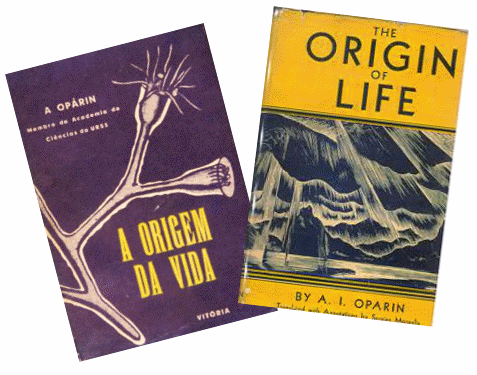In the 60’s, while I was still a student, a Russian book fascinated me. In fact, at the time, besides studying physics, I was doing research in bionics and participating in a discussion group whose central theme was the unusual. APEX, an Association of exological research, discussed everything from UFOs to the communication between plants and paranormal phenomena.
The book dealt precisely with the long road that led nature to come to us, and it didn't stop there. Life could continue to evolve and more, go through a transition that might totally change everything, and it is clear from our thinking now when we become aware that this could indeed happen.
Aleksandr Oparin's book, Origin of Life, speculated that life could not necessarily be based on carbon alone.
According to the author, carbon is the only substance that can originate complex chains, presenting the ability to self-reproduce at low temperatures, specifically in the range in which water remains liquid and can then act as a catalyst.
However, there is another substance that could give origin to complex structures, but this would not occur at low temperatures, which prevents it from being the natural origin of life in our universe. It is precisely the silicon, which is one of the most abundant substances in our universe.
However, we are seeing that if silicon cannot give origin to natural living forms, it can perfectly be the basis for the creation of artificial living forms, created precisely by the natural life forms that we are.
Over the years, with the ever-increasing development of physics and the semiconductor technology, based precisely on silicon, we are feeling that this may indeed be happening now.
Of course, we will not suddenly see creatures like Commander Date from Star Trek among us or complete creatures with intelligence and immediately crafted.
The process should be gradual and that is exactly what we are witnessing.

One of the possibilities comes precisely from what we are already observing nowadays is the increasing approximation of electronic technology to living beings.
In the past, when electronics was still in its early days, it was a curiosity, a kind of "magic" far from the average public. The very radio that was taking its first steps was handled only by its owners and in a house, other people, the "lay person" could not touch it. There was a touch of magic to these devices that created a barrier between users and them.
This, within time was disappearing and soon the technology, still with the valves created other devices.
In a later phase the devices started to interact more with the people being created the walk-talkies and others that reached a larger number of users.
With the arrival of the transistor and the integrated circuit, electronics began to be carried by people, in a larger integration, where the devices no longer belonged to the house and not a person. It was the transistor radios, portable recorders and calculators that became popular.
With the advancement of all this we come to integrable chips in many different things, giving rise to IoT (Internet of Things), IoM (Internet of Medical Things) and with it the entry into the human body.
Parallel to all this, the chips themselves came to integrate such a large number of components that artificial intelligence resources were integrated. But all this is still far from what can be called life, but the way was being traced.
In 1968, I wrote an article talking about self-repairing circuits whinchat can be considered a feature of living things, in which they reproduce damaged cells, for example, to heal a wound.
Now, this is one of the characteristics of living beings that can suddenly be integrated into circuits, starting with what would be a chip that can “cure” a defect.
Another feature of living beings that must be considered is the reproduction. A chip or electronic device cannot reproduce itself but can be reproduced by other electronic devices. Perhaps this is one of the characteristics of artificial life in the future that will differentiate it from carbon life. Its reproduction is artificial, made by machines.
However, it will integrate the resources of artificial intelligence and self-healing, and of course it can even determine its reproduction by controlling it.
No doubt, there are the deeper aspects to be discussed, such as what we call "soul" or "spirit."
Researchers dealing with this subject in relation to humans are making many important discoveries which indicate a convergence of science with the so-called "parasciences" or even religions, and an interesting subject is precisely the subject of "soul" and "mind".
Some studies, still in their early stages, seem to indicate that our mind has quantum computing capabilities that would involve contacts with other dimensions or across other dimensions.
This would explain things like consciousness and some skills we have that could not be explained only by the number of neurons we have and their quantity.
There would be structures in neurons capable of giving us "extra" capabilities that cannot be explained in the conventional way. With the advancement of nanotechnology, these structures could be added to artificial life chips and, at least for the moment, we cannot predict how they would behave with the mind or soul issue.
This is very intriguing, but science is advancing, and it is very difficult to predict whether this is just a speculation or if we are on the way to becoming a reality.
It's up to everyone to think about it. We will come back with these issues as research progresses and our knowledge of these issues leaves the field of technology and advances through other quite complex areas such as philosophy, religion and more.




